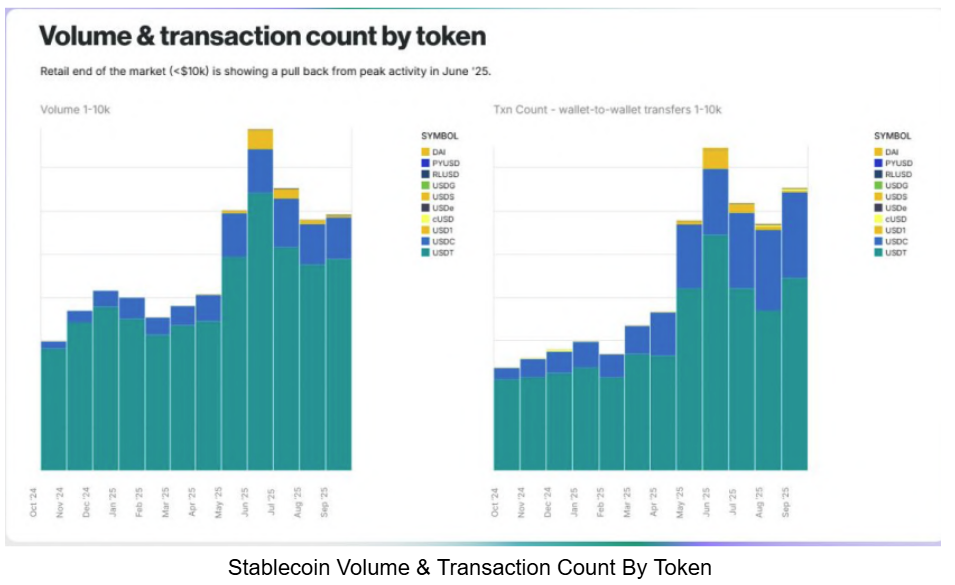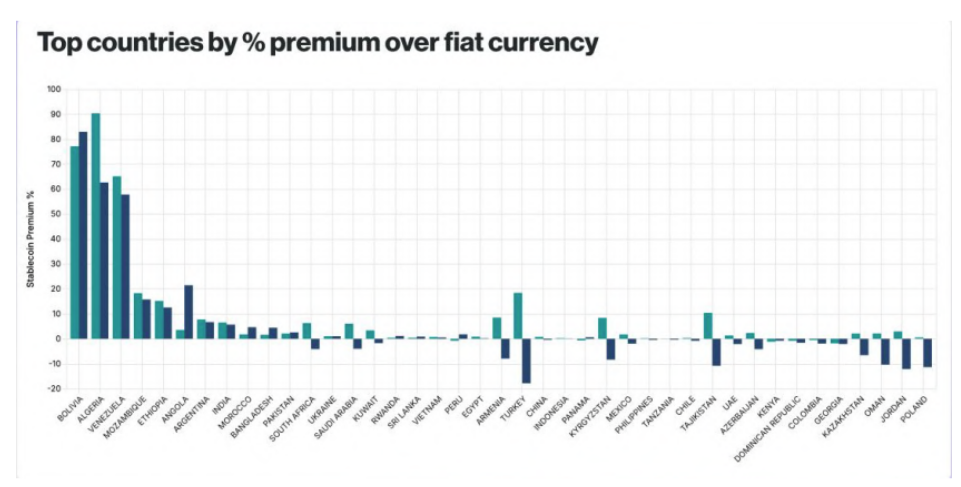Stablecoin Payments Soar $41B in Q3 2025: Real Use Surges

Key Points
- Stablecoin payments recorded $41 billion in net inflows during Q3 2025, marking the strongest quarterly expansion since 2021.
- Retail adoption has shifted from speculative trading to practical, everyday use, especially in emerging economies.
- Daily active users stabilized at 3.6 million in Q3, following intense growth in previous periods.
- Retail payment volumes increased by 4% to $1.77 trillion, driven by larger transactions exceeding $10,000.
- Tether (USDT) dominates retail transactions (83%), while USDC leads in DeFi (over 50%).
- Emerging markets are increasingly leveraging stablecoins as a hedge against inflation, paying significant premiums for dollar-pegged tokens.
- New blockchains like Plasma and established ones like Ethereum and Tron are fiercely competing for stablecoin traffic.
The Maturation of Stablecoin Utility: Beyond Speculation
The third quarter of 2025 witnessed a pivotal moment in the stablecoin market, as it registered its most robust quarterly expansion since 2021, with an impressive $41 billion in net inflows. This substantial growth signals a profound shift within the cryptocurrency industry: a definitive move away from purely speculative trading towards the practical, everyday utility of stablecoins. This evolution is particularly pronounced in emerging economies, where these digital assets are increasingly integrated into daily financial transactions, offering a much-needed layer of stability.
According to Orbital’s Stablecoin Retail Payments Index, the retail adoption landscape for stablecoins has entered a new, more stable phase. This follows a period of intense growth and user acquisition, reflecting a market that is finding its equilibrium. The data underscores a broader narrative where the inherent value proposition of stablecoins – their peg to fiat currencies, typically the US dollar – is being realized in real-world applications, rather than solely as a trading instrument.
Retail Activity Stabilizes Amidst Market Balance
Following a remarkable 69% surge in user adoption between mid-2024 and mid-2025, stablecoin activity has shown signs of settling into a more consistent pattern. The third quarter reported approximately 3.6 million daily active users, indicating a market that, while no longer experiencing exponential user growth, has firmly established a substantial and engaged user base. This stabilization suggests that the initial fervor has given way to sustained engagement, a healthy indicator of long-term viability.
Crucially, even as the number of transactions saw a slight dip from 1.33 billion to 1.21 billion, retail payment volumes climbed by a respectable 4% to reach an astounding $1.77 trillion. This seemingly counterintuitive trend points to a significant behavioral shift: smaller transactions below $10,000, which characterized earlier quarters, are now being supplanted by larger, more substantial transfers. This development suggests a growing confidence in stablecoins for higher-value financial activities, further solidifying their role in the broader economy.

Dominance and Enabling Infrastructure
Within the stablecoin ecosystem, Tether’s flagship token, USDT, continues its commanding presence in the retail sector, facilitating a remarkable 83% of all retail transactions. This dominance underscores its entrenched position as the preferred medium for everyday value transfer. Conversely, USDC has cemented its status as the favored token among Decentralized Finance (DeFi) users, accounting for over 50% of the total DeFi market. This bifurcation highlights the distinct use cases and user preferences shaping the stablecoin landscape.
In terms of infrastructure, Binance emerges as a critical player, controlling a significant portion of the liquidity for both USDT and USDC. More importantly, Binance provides the essential rails for retail payments, particularly across the dynamic and rapidly evolving markets of emerging economies. Its extensive reach and robust platform are instrumental in enabling the seamless flow of stablecoin transactions, thus empowering users in regions that often grapple with traditional financial hurdles.
Emerging Markets: Stablecoins as a Bulwark Against Inflation
One of the most compelling narratives in the stablecoin surge is their increasing adoption as vital economic lifelines in struggling economies. In nations battling rampant inflation and currency instability, stablecoins offer a digital haven, functioning effectively as a digital equivalent of the US dollar. This trend has not gone unnoticed by prominent financial analysts, with figures like Ark Invest CEO Cathie Wood acknowledging the growing popularity of stablecoins as a significant factor in broader crypto market dynamics.
Orbital’s report vividly illustrates this phenomenon, revealing that users in countries such as Algeria, Bolivia, and Venezuela are willing to pay staggering premiums of 90%, 77%, and 63% respectively to acquire dollar-pegged tokens. These exorbitant premiums are a stark testament to the urgent demand for stable assets in environments where local currencies are rapidly depreciating. Mid-tier premium ranges, between 8% and 18%, are observed in countries like Türkiye, Ethiopia, and Argentina, indicating similar, though less acute, pressures.
In contrast, markets like India, Saudi Arabia, and South Africa exhibit lower premiums, a reflection of improved financial infrastructure and greater ease in accessing and trading stablecoins near market rates. Intriguingly, some nations, including Colombia and Peru, even trade below parity. This indicates stronger liquidity, a more mature market, and potentially an abundance of stablecoin supply relative to immediate demand, signaling robust market development.

The Blockchain Landscape: A Battle for Stablecoin Traffic
The burgeoning stablecoin market has intensified competition among blockchain platforms, each vying for a larger share of transaction traffic. While Binance Smart Chain (BSC) still leads in retail transfers, its growth rate has decelerated by half in Q3, suggesting that newer entrants and established rivals are gaining traction.
Aptos, after a massive breakout earlier in the year, has now stabilized, maintaining a consistent flow of transactions. A notable new entrant, Plasma, made a significant impact by setting a record of $7 billion in deposits within days of launching its native token, XPL. This rapid adoption underscores the market's appetite for innovative and efficient stablecoin infrastructure.
Tron, buoyed by its heavy USDT usage, continued its steady ascent, solidifying its position as a reliable platform for stablecoin transfers. Ethereum, the pioneering smart contract platform, saw its total stablecoin supply expand by an impressive $35 billion, reinforcing its foundational role in the wider crypto ecosystem, despite facing competition from faster and cheaper alternatives. The dynamic interplay between these blockchains highlights the ongoing evolution and decentralization of the stablecoin payment rails.

The Road Ahead for Stablecoins
With the current stablecoin market capitalization hovering around $311 billion, as reported by CoinGecko, the trajectory for these digital assets appears set for continued growth and deeper integration into the global financial fabric. The shift from speculative interest to tangible utility, especially in providing financial stability in volatile economies, marks a significant milestone. As innovations in blockchain technology continue and regulatory clarity emerges, stablecoins are poised to play an increasingly vital role, bridging the gap between traditional finance and the decentralized future, and fundamentally reshaping how value is transferred and stored worldwide.
